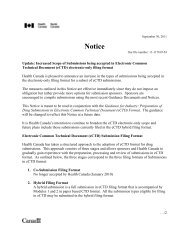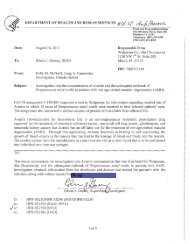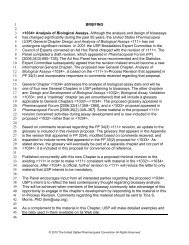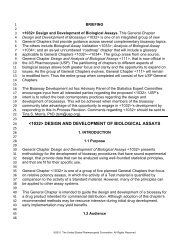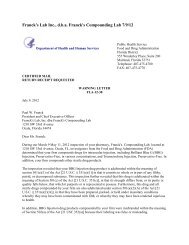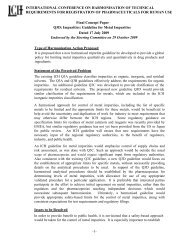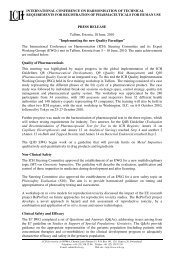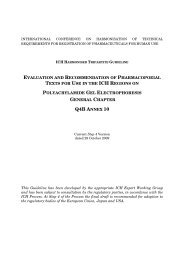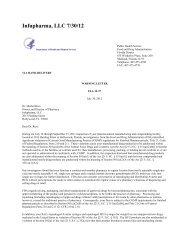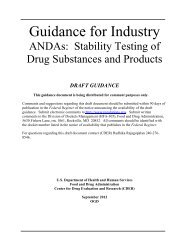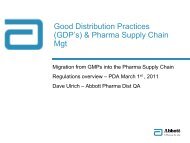BEPBA Bioassay Conference Agenda - IPQ
BEPBA Bioassay Conference Agenda - IPQ
BEPBA Bioassay Conference Agenda - IPQ
Create successful ePaper yourself
Turn your PDF publications into a flip-book with our unique Google optimized e-Paper software.
Location chosen<br />
by Attendees!<br />
Preliminary Brochure<br />
Biological<br />
Assays<br />
<strong>Conference</strong><br />
All 3 days for<br />
Under €1000.00<br />
29 September — 1 October 2010, Barcelona, Spain<br />
Hear from the following<br />
Organizations:<br />
Ablynx<br />
BCG<br />
Biogen-Idec<br />
BioAnaLab Ltd.<br />
Bureco AG<br />
Covance<br />
DDL Diagnostic Lab<br />
EMA<br />
GlaxoSmithKline<br />
Global Cellular Analytics<br />
HPA<br />
Institute Andre Lwoff<br />
MedImmune<br />
NIBSC<br />
Novartis Biologics<br />
Premas Biotech Pvt. Ltd<br />
Precision <strong>Bioassay</strong>s<br />
Protagen AG<br />
Quality Services<br />
Statistical Designs<br />
Main <strong>Conference</strong>Topics<br />
• EMA Speaker Provides an EU Regulator’s<br />
Perspective on <strong>Bioassay</strong>s<br />
• Industry Authors Summarize Soon to be Published White<br />
Paper on ADCC Assays and How to Replace Them<br />
• Practical Advice for Determining Reference and Test Article<br />
Similarity<br />
• Developing and Validating Multiplex <strong>Bioassay</strong>s<br />
• <strong>Bioassay</strong>s to Support Product Release: Beyond Potency<br />
• Tips on How to Correlate Functional and Binding Assays<br />
Plus! Pre-<strong>Conference</strong> <strong>Bioassay</strong> Tools Workshop<br />
Be sure to attend this interactive and practical Workshop. If you are<br />
struggling with implementing the new USP recommendations, or want<br />
to learn about the array of useful statistical tools to speed up assay<br />
development and validation be sure to attend this workshop.<br />
Case Studies<br />
…….and Cases Studies!<br />
• Cell-Based Potency Assays<br />
• Functional Surface Plasmon Resonance Assays<br />
• One Step Neutralizing Antibody Assays<br />
• Report Gene Assays<br />
• Using DOE to Develop a Cell-Based BioAssay<br />
• Validating a Difficult NAB Cell-Based Assay<br />
• Replacing ADCC Assays<br />
Not-for-Profit Meeting:<br />
Practical and Scientific: Developed by Scientist for Scientists<br />
Contact us at: www.BEBPA.org Phone: +1-916-729-0109<br />
Fax:1-916-729-2602<br />
Practical and Scientific: Developed by Scientists for Scientists
BEBPA’s 3rd Annual Biological Assay <strong>Conference</strong><br />
Pre-<strong>Conference</strong> Workshop: Practical Tools for the <strong>Bioassay</strong> Scientist<br />
8:15—8:30 Open of Workshop: Organizers’ Comments<br />
Laureen Little, PhD, Principal Consultant, Quality Services<br />
8:30—9:30 Primer for the Statistical Design of Experiments<br />
(DOE)<br />
Simply put, experiments are carried out to obtain unknown<br />
information. Statistical concepts applied to the design of experiments<br />
can make the experiments more efficient, more effective,<br />
and therefore more productive—that is, statistically<br />
designed experiments can obtain the required information with<br />
a minimum expenditure of resources (a desirable business<br />
goal!). This brief introduction will discuss the important topics<br />
of replication to measure and minimize the effects of purely<br />
experimental uncertainty: factor interaction; and the use of<br />
broad designs to minimize uncertainty in the results. Various<br />
classical experimental designs will be introduced.<br />
Dr. Stanley Deming, President, Statistical Designs, USA<br />
9:30-10:15 Design Of Experiments in the Framework of a<br />
Cell Based Potency Assay<br />
Biological assays for measuring the potency of a therapeutic<br />
drug candidate are critical components to monitor its quality<br />
and stability. These potency assays should describe the specific<br />
ability or capacity of a product to achieve a defined biological<br />
effect. In the given example this biological effect is<br />
measured in a virus neutralization assay. In particular, for the<br />
development of this assay, accuracy, precision and window of<br />
the virus neutralization curve had to be optimized as a function<br />
of seven potentially critical factors. The design and the analysis<br />
of these experiments are discussed. For the design of experiments<br />
(DOE) part, some important issues concerning the<br />
randomization scheme, blocking and hard-to-change variables<br />
are highlighted. Additionally, the impact of changing the design<br />
settings before and during experimentation is discussed. For<br />
the analysis part, multiple responses that should be optimized<br />
together if possible are dealt with. The problem of missing data<br />
is also tackled by using multiple imputation techniques. Finally,<br />
the resulting optimal factor settings together with the final<br />
model are tested through additional experiments.<br />
Dr. Katrien Verschueren, Biostatistician, Ablynx, Belgium<br />
10:15—10:45 Morning Break<br />
10:45-11:30 Application of DoE in <strong>Bioassay</strong> Development:<br />
A One Day Simplified Muli-Factorial DoE Approach Addressing<br />
<strong>Bioassay</strong> Robustness<br />
Dr. Hyun (Jun) Kim, Associate Scientist II, MedImmune,<br />
USA<br />
11:30-12:15 Validation of Relative EC50 ELISA Assays<br />
We will discuss a case study for the validation of these types<br />
Three Ways to Register<br />
of ELISAs. The design and outcome for all ICH parameters will<br />
be reviewed together with lessons learned. We will also briefly<br />
discuss the statistical design of the assay and the analysis of<br />
validation data.<br />
Matthew Trickett, Experimental officer, Covance Labs, UK<br />
12:15—1:30 Luncheon<br />
1:30-2:15 Strategies to Reduce Noise-Dependant Censoring<br />
Bias in <strong>Bioassay</strong>s<br />
Bias, like relative potency, can be most efficiently estimated<br />
within-assay. A common result is attenuation of estimated potency<br />
that increases with differences between sample and reference<br />
potency. This is also seen in computer simulation experiments<br />
where attenuation also increases with noise around<br />
the fitted lines or curves, often acting via similarity failures. In<br />
linear model bioassay the noise-induced bias partially depends<br />
on the strategy used to select near-linear portions of the response<br />
curves. Potency bias depends on the assay design,<br />
the potency range, the analysis method, and the variation in<br />
the assay. Careful study of how these combine can inform<br />
many strategic choices in bioassay design, analysis, and use.<br />
Dr. David Lansky, President, Precision <strong>Bioassay</strong><br />
2:15-3:15 Primer: USP Approaches to Similarity and Modeling<br />
for the Bench Scientist<br />
Presenter to be Determined<br />
3:15—3:45 Exhibit/Poster and Refreshment Break<br />
3:45-4:30 Parallelism Testing of Four-parameter Logistic<br />
Curves for <strong>Bioassay</strong>: A Case Study for Implementation of<br />
USP <strong>Bioassay</strong> Guidance<br />
Dr. Hyun (Jun) Kim, Associate Scientist II, MedImmune, USA<br />
4:30-5:15. Detecting "Non-Parallelism" using Residual<br />
Sums of Squares from a Parameter Logistic Model.<br />
Making the reasonable assumption that all wells on a bioassay<br />
plate have been prepared uniformly, it is then reasonable to fit<br />
a four-parameter logistic (4PL) model that has a single upper<br />
asymptote parameter, a single lower asymptote parameter,<br />
and a single slope parameter (common parameters) for reference<br />
standard, control, and test samples applied to the plate;<br />
each sample has it's own "C" parameter (related to its log<br />
[ED50]) in the model. For individual samples that behave similarly,<br />
their average sums of squares of residuals (SSR) are<br />
expected to be approximately the same; for a non-similar (nonparallel)<br />
sample, its SSR is expected to be inflated. Experience<br />
with real samples shows this to be true. The average<br />
SSR is also useful for detecting what appear to be sequential<br />
pipeting errors and "bad" wells on a plate.<br />
Annemarie King, HPA, UK<br />
5:15 End of Workshop<br />
www.BEBPA.org Telephone: +1-916-729-0109<br />
Fax:1-916-729-2602
BEBPA’s 3nd Annual Biological Assay <strong>Conference</strong><br />
Main <strong>Conference</strong>, Day 1: 30 September 2010<br />
8:00-8:15 Open of <strong>Conference</strong>: Welcome and BEBPA<br />
Update<br />
Laureen Little, PhD, Principal Consultant, Quality Services<br />
Functional Assays for Antibodies: ADCC and Beyond<br />
Session Chairs: Hans-Joachim Wallny, PhD, Novartis and<br />
Xu-Rong Jiang, Ph.D., M.D., MedImmune, LLC<br />
Keynote Address<br />
8:15-9:15 Development, Validation and Real-life Experience<br />
of a Potency Assay for an Anti-Cytokine mAb<br />
A potency assay was developed to support release and stability<br />
testing of GMP drug substance and drug product of a fully<br />
human monoclonal antibody targeting a cytokine. The potency<br />
assay is based on inhibition of a transcription factor essential<br />
for biological function of the cytokine. The presentation will<br />
focus on assay development and validation, the establishment<br />
of procedures to monitor assay performance, as well as issues<br />
that became apparent during routine use of the assay and how<br />
these were addressed.<br />
Dr. Thomas Millward, Group Head Bioanalytics, Novartis<br />
Biologics, Switzerland<br />
9:15-10:00 A Strategy for Assessment of Effector Functions<br />
of Therapeutic Monoclonal Antibodies (this is an<br />
overview of the Fc effector function characterization<br />
whitepaper co-authored by experts from Amgen,<br />
Genentech, Biogen Idec, Merck, Eli Lilly & MedImmune)<br />
The Fc region of therapeutic monoclonal antibodies can play<br />
an important role in safety and efficacy. Although much is<br />
known about the structure-activity relationship of antibodies<br />
and the factors that influence Fc effector functions, it remains<br />
unclear how manufacturers should assess and control Fc functionality.<br />
We present a control strategy.<br />
Dr. Xu-Rong Jiang, Associate Director, MedImmune, US<br />
10:00—10:30 Morning Break<br />
10:30-11:15 Correlation Between Binding and Cell-based<br />
Functional Potency Assays<br />
Dr. Svetlana Bergelson, Associate Director, Biogen Idec, US<br />
11:15-12:00 Functional Analysis of Therapeutic Monoclonal<br />
Antibodies Using Surface Plasmon Resonance<br />
(SPR) and Flow Cytometry (FC)<br />
ADCC is an important mode of action for many monoclonal<br />
antibodies but these assays are challenging to develop. We<br />
showed binding of the prototypic humanised antibody alemtuzumab<br />
to the critical Fc gamma RIII receptor, measured by<br />
SPR and FC, correlates with physiological activity measured<br />
by ADCC. Glycoengineered antibodies with different levels of<br />
binding activity were used to show the sensitivity and specificity<br />
of the method. The Fcgamma RIII ligand binding assays<br />
provide a functionally relevant indicator of product quality for<br />
batch release and stability testing.<br />
Dr. Alice Harrison, GMP Services Manager, BioAnaLab, UK<br />
BioAssay Statistical Tools<br />
12:00-1:30 Luncheon<br />
Three Ways to Register<br />
www.BEBPA.org Telephone: +1-916-729-0109<br />
Chair: Dr. Stanley Deming, President, Statistical Designs<br />
1:30-2:15 Specifications and Fundamental Statistics<br />
As ICH clearly points out, the only rational basis for setting<br />
specifications is based on fitness for use, considerations usually<br />
involve safety and efficacy. From Q6B: "Acceptance criteria<br />
should be established and justified based on data obtained<br />
from lots used in preclinical and/or clinical studies.." The common<br />
practice of setting specifications based on current performance<br />
of an existing process without evaluating fitness for<br />
use carries two risks: risk to the customer, and risk to the<br />
manufacturer. Further, the common use of arbitrary numbers<br />
of "sigmas" to set simple specifications (for example, in batch<br />
release testing) often involves risks that are inappropriately<br />
large for the business application. "Specifications for the<br />
Chemical and Process Industries...", ISBN 0-87389-351-4, is<br />
recommended.<br />
Dr. Stanley Deming, President, Statistical Designs, USA<br />
2:15-3:00 Managing Quality Assessment via Study Design<br />
<strong>Bioassay</strong>s are an integral part of the quality assessment required<br />
for manufacturing pharmaceutical and biological products.<br />
<strong>Bioassay</strong>s differ from chemical methods in their inherent<br />
variability stemming from the influences of multiple operational<br />
and biological factors. The influence of these factors can be<br />
managed through strategic study design after identification<br />
during development and validation. Both randomization and<br />
replication are utilized to improve measurement reliability.<br />
Release assays may be designed to manage the risk of OOS<br />
results, while stability studies are designed to minimize the<br />
uncertainty associated with the measurement of the degradation<br />
rate of the product.<br />
Timothy Schofield, Director, GlaxoSmithKline, US<br />
3:00—3:30 Exhibit/Poster and Refreshment Break<br />
Multiplex Assays<br />
Increased pressure on researchers to gain greater understanding<br />
of products, protein interaction, identification of markers<br />
etc has led to a number of emerging technologies offering<br />
‘multiplexing’ of assays. Multiplex assays are designed to generate<br />
simultaneous measures from a single sample against<br />
multiple analytes. This session will describe the promises and<br />
pitfalls of ‘multiplexing’ and describes two case studies on the<br />
development and validation of multiplexed assays.<br />
Session Chairs: Bassam Hallis, PhD, HPA and Thierry<br />
Pascal, PhD, GSK<br />
3:30-4:15 Promises and Pitfalls of multiplexing!<br />
Dr. Bassam Hallis, General Project Manager, HPA, UK<br />
4:15-5:00 Validation of a Multiplex Luminex ImmunoAssay<br />
(MLIA) for Assessment of the Immunogenicity of Bordetella<br />
Pertussis Vaccines<br />
Dr Nathalie Durant,GlaxoSmithKline Biologicals, Belgium<br />
5:00-5:45 Validation of the HPV Genotyping Assay<br />
Bernhard Kleter, DDL Diagnostic Laboratory<br />
5:45 No Host Networking Reception in Bar<br />
Fax:1-916-729-2602
BEBPA’s 3rd Annual Biological Assay <strong>Conference</strong><br />
Main <strong>Conference</strong>, Day 2: 1 October, 2010<br />
8:00-8:05 Chairperson’s Opening Remarks<br />
Dr. Laureen Little, Principal Consultant, Quality Services<br />
8:05-9:00: Opening Address:<br />
Recent EU Regulatory Experiences with BioAssays<br />
Dr. Peter Richardson, Head of Biologicals, Quality of<br />
Medicines Sector, European Medicines Agency<br />
Neutralizing Antibody Assays<br />
9:00-9:45 A Novel One-Step BioAssay for the Quantification<br />
of Neutralizing Antibodies<br />
A unique one-step bioassay was developed that overcomes<br />
limitations of conventional cell-based assays. This technology<br />
allows both drug activity and anti-drug neutralizing antibodies<br />
(NAbs) to be quantified rapidly and precisely in the<br />
same sample simply by adding reporter cells. Reporter cells<br />
express a reporter gene under control of a drug-responsive<br />
promoter, and express the drug normalized relative to an<br />
internal standard. Assay results are independent of cell<br />
number or differences in cell viability.<br />
Dr. Michael Tovey, Director, Instit. Andre Lwoff, France.<br />
9:45-10:30 Development and Validation of a Difficult Neutralizing<br />
Antibody (NAB) Assay: A Case Study.<br />
We developed and validated a cell based assay for determining<br />
neutralizing antibodies (NAB) directed against a molecule with<br />
endocrine activity. The assay was developed based on a potency<br />
assay with a cAMP read out. Most critical parameters<br />
were low signal-to noise ratio, high variability, and a tremendous<br />
influence of the matrix. By optimizing assay conditions and parameters<br />
a satisfactory NAB assay was established, validated<br />
and implemented.<br />
Dr. Gisela Peraus, Bureco AG, Switzerland<br />
10:30—11:00: Break<br />
11:00-11:45 Dilutional Linearity (DL) for NAB Assays<br />
Neutralizing antibody (NAB) serological assays routinely proceed<br />
without assessing similarity among specimen doseresponse<br />
curves. This lack of similarity can manifest as specimen-specific<br />
dilution bias. Test samples typically have activities<br />
several folds wider than the dynamic range of the assay, which<br />
further narrows acceptable bias. These two features make DL<br />
assessment essential for NAb assays. The DL study documents<br />
sample effect dilution on assay precision and bias. Sources of<br />
error can be categorized into five distinct types. Care must be<br />
taken to measure and account for each.<br />
Dr. David Lansky, President, Precision <strong>Bioassay</strong>, USA<br />
Beyond Potency—Cell-based <strong>Bioassay</strong>s in Quality<br />
Session Chair: Dr. Nadine Ritter, Consultant, BCG, USA<br />
11:45-12:30 Modifications in Therapeutic MAb Products:<br />
Isoforms or Impurities?<br />
Therapeutic Mabs are complex molecules and are prone to several<br />
modifications during production process and storage. Potency<br />
assays play a key role in determining whether these modifications<br />
are impurities or product related isoforms. Real life<br />
case studies will be presented.<br />
Dr Venkat Mukku, Global Cellular Analytic Solutions US<br />
Three Ways to Register<br />
www.BEBPA.org Telephone: +1-916-729-0109<br />
12:30—1:30 Lunch<br />
1:30-2:15 Protein Microarrays in Combination with Cell<br />
Based <strong>Bioassay</strong>s are More Reliable for Stability Testing<br />
Stability a major concern for quality, efficacy and safety of therapeutic<br />
active monoclonal antibodies. Reliable and fast evaluation<br />
tools are required for screening during product development<br />
and ICH compliant stability testing. The combination of well accepted<br />
cell based bioassays, modern protein microarrays and<br />
classical structure characterization techniques allows a unique<br />
and comprehensive view on mAB degradation pathways and<br />
characteristics. Advantages and disadvantages of different analytical<br />
approaches as well as synergetic effects due to method<br />
combination will be presented.<br />
Dr. Katja Aschermann, Manager, Protagen AG, Germany<br />
Session Title: Hands On Session - Case Studies<br />
Session Chair: Dr. Jane Robinson, NIBSC, UK<br />
2:15-3:00 Preclinical Development of Nanobodies® : Challenges<br />
in Potency Assay Development<br />
Nanobodies® are a novel class of therapeutic proteins based<br />
on the smallest functional fragments of heavy chain antibodies,<br />
which occur naturally in the Camelidae family. This platform<br />
has lead to a wide range of Nanobody formats, including unique<br />
multivalent, biparatopic, and bispecific compounds. Such flexibility<br />
provides a challenge in the development of stability indicating<br />
potency assays. This case study discusses the development<br />
of various potency assays for release and stability testing. Examples<br />
demonstrate how assays were optimized to discriminate<br />
between the multivalent or biparatopic Nanobody formats and<br />
their monovalent analogues.<br />
Dr. Hans Ulrichts, Sr. Scientist, Ablynx, Belgium<br />
3:00-3:30 Poster Talks<br />
Back by popular demand! Two posters will be selected for 15<br />
minute presentations in the main conference. This is great opportunity<br />
for students and junior analysts to present.<br />
Presenters to be selected day 1 of the conference.<br />
3:30—4:00 Exhibit/Poster and Refreshment Break<br />
4:00-4:45 Development of a Whole Blood Cell Depletion<br />
Assay for Characterization of Therapeutic Antibodies<br />
Directed Against Lymphoid Targets<br />
Dr. Roger Grau, Novartis Biologics, Switzerland<br />
4:45-5:30 Case studies from India: Development of Cell<br />
Based Reporter Gene Assays for Biosimilars.<br />
<strong>Bioassay</strong>s are the only non-clinical tests that indicate a<br />
biosimilar product is biologically active. Cell based reporter<br />
gene assays are the benchmark to prove functional similarity<br />
of a biosimilar to the originator molecule. We present a case<br />
study on the development of an in vitro reporter gene assay<br />
using luciferase to determine the potency of a biosimilar<br />
erythropoietin (EPO).<br />
Rajeev Soni, President and COO, Premas Biotech<br />
Chairperson’s closing comments and selection on next<br />
year’s meeting venue<br />
5:45 <strong>Conference</strong> Adjourns<br />
Fax:1-916-729-2602
BEBPA’s 3rd Annual Biological Assay <strong>Conference</strong><br />
Assay Monitoring Round Table Discussions<br />
Wednesday, 29 September 2010 7PM<br />
Come join us for the first white paper discussion group. Last year, in Rome, workshop<br />
attendees learned about various problems associated with maintaining cell-based potency<br />
assays for routine use. This year ideas from this workshop and any others you<br />
bring to the table will be included in BEBPA's first non-concensus white paper.<br />
The Topic:<br />
Assay Monitoring for cell-based assays is a critical activity for maintaining and using<br />
assays for routine product release. Currently there are no standardized terminology or<br />
practices. Regulatory guidance is non-existent and industry standards are vague and<br />
highly variable.<br />
The Approach:<br />
This round table will focus on proposing terminology and various parameters for monitoring<br />
as well as explore statistical approaches for setting action limits. Dr. Michael<br />
Sadick will facilitate the discussion while a note taker records suggestions and comments.<br />
All suggestions will be complied into a publicly available white paper to be<br />
posted on the BEBPA web page. Attendees are encouraged to bring ideas, slides,<br />
handouts or any other form of notes they are interested in having included in the white<br />
paper. No companies or individuals will be identified with specific recommendations<br />
unless they specifically request recognition.<br />
BioQuality Newsletter<br />
Www.bioquality.biz<br />
www.statisticaldesigns.com/<br />
Interested in Becoming a Sponsor?<br />
Contact Us Today:<br />
Meeting Sponsors: Your name and logo on all marketing brochures,<br />
behind the registration desk and in meeting handouts €1000<br />
Exhibitors: Exhibiting Space in registration area for table top booth €2000<br />
Exhibiting Sponsors: Includes Both Meeting Sponsors and Exhibitor<br />
Benefits €2500<br />
Scholarship<br />
Available<br />
Special Thank You to Our Sponsors<br />
Distinguished<br />
Presenters<br />
Katja Aschermann<br />
Svetlana Bergelson<br />
Stanley Deming<br />
Nathalie Durant<br />
Roger Grau<br />
Bassam Hallis<br />
Alice Harrison<br />
Xu-Rong Jiang<br />
Hyun (Jun) Kim<br />
Annemarie King<br />
Bernhard Kleter<br />
David Lansky<br />
Laureen Little<br />
Thomas Millward<br />
Venkat Mukku<br />
Gisela Peraus<br />
Pamela Proud<br />
Peter Richardson<br />
Nadine Ritter<br />
Jane Robinson<br />
Timothy Schofield<br />
Rajeeve Soni<br />
Michael Tovey<br />
Matthew Trickett<br />
Hans Ulrichts<br />
Katrien Verschueren<br />
Meeting Organizers:<br />
Laureen Little<br />
C. Jane Robinson<br />
Hans-Joachim Wallny<br />
Stanley Deming<br />
Bassam Hallis<br />
Meeting Attendee Scholarship Available!! Promega is Supporting<br />
BEBPA Through Meeting Scholarships. Submit a Poster and<br />
You will be Automatically Eligible for a Free Meeting Attendance.
BEBPA’s 3rd Annual Biological Assay <strong>Conference</strong><br />
Reserve Your Place Today<br />
Name: Dr/Mr./Ms<br />
Email:<br />
Job Title<br />
Phone Number<br />
Department<br />
Hotel Information<br />
Hotel Avenida Palace<br />
Gran Via de les Corts<br />
Catalanes, 605 · 08007<br />
Barcelona (España) ·<br />
Tel: 933019600 ·<br />
Fax: 933181234<br />
www.avenidapalace.com/en/<br />
Company<br />
Address:<br />
4 Easy Ways<br />
to Register<br />
Country/Postal Code<br />
Please Indicate Payment Method<br />
Enclosed Check (Payable to: BEBPA)<br />
Credit Card<br />
Visa Master Card Amex<br />
✉<br />
☏<br />
Fill out this sheet and<br />
mail to:<br />
BEBPA<br />
PO Box 7087<br />
Citrus Heights, CA<br />
95621<br />
USA<br />
Call:<br />
+1-916-729-0109<br />
Card Holder<br />
Card Number<br />
Signature<br />
Expiry Date<br />
Enjoy a High Quality Meeting at Not-for-Profit Prices<br />
<br />
<br />
Register on line:<br />
www.BEBPA.org<br />
Follow link to<br />
upcoming<br />
conferences<br />
Fax:<br />
+1-916-729-2602<br />
3 Day Package ; 2 day conference + 1 Day Workshop - €960.00<br />
2 Day Package ; 2 day conference - €750.00<br />
Please Sign Me Up for a Poster Presentation - €50.00 in addition to meeting fee<br />
BEBPA: Who are We? What Do We Aim to Accomplish?<br />
The Biopharmaceutical Emerging Best Practices Association (BEBPA) is a not-for-profit association, founded in 2008,<br />
managed by and for the benefit of the biopharmaceutical scientific community. BEBPA provides an open forum for<br />
the presentation and discussion of scientific issues and problems encountered in the biopharmaceutical community.



